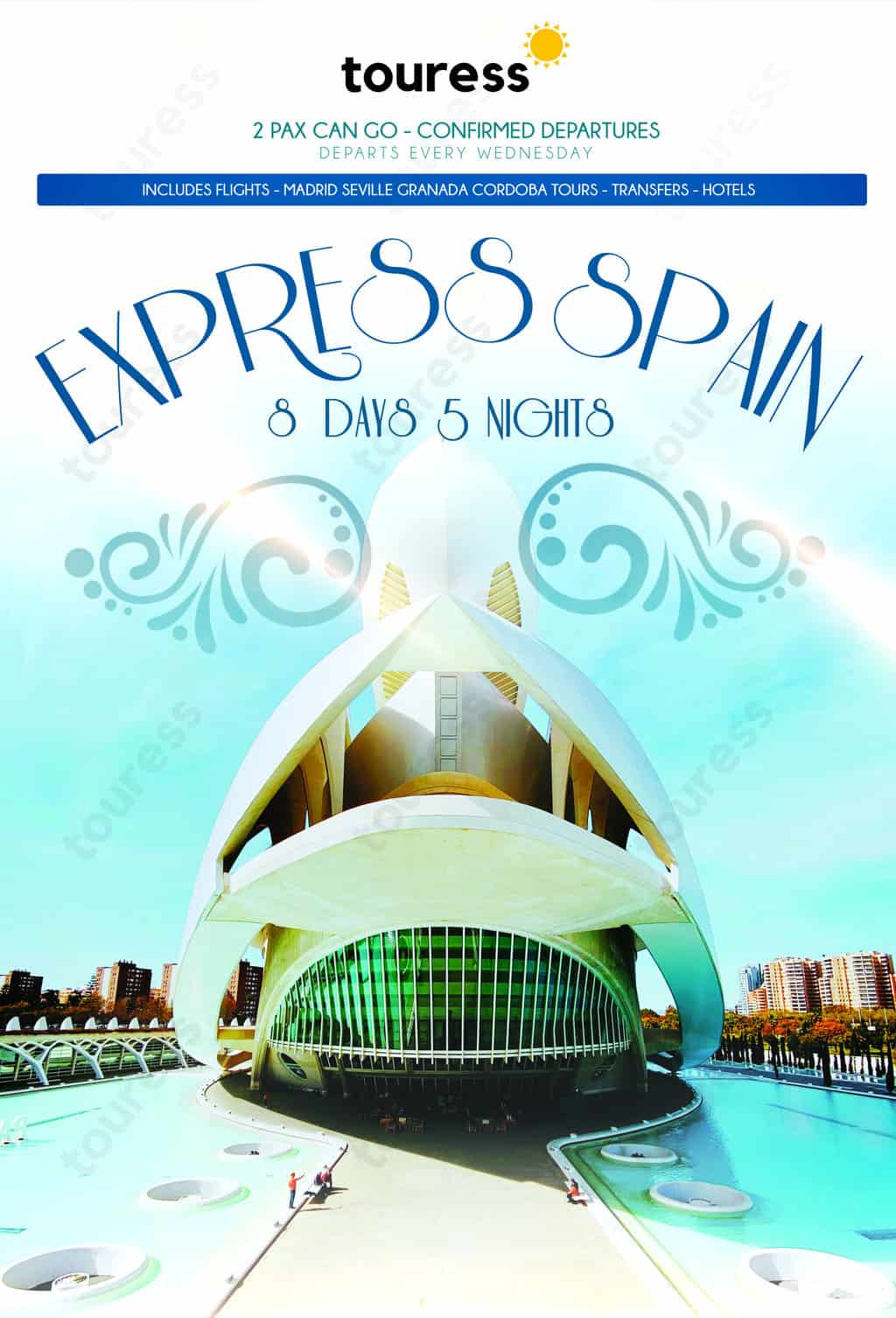Itinerary
D1 WED JAKARTA – MADRID
1800 Flights Check-In
2100 Departure to Madrid (Spain)
D2 THU MADRID
1030 Arrival in Madrid
1130 Airport Pickup
1230 Hotel Drop Off and Baggage Drop Off
1400 Hotel Check-In and Free Session in Madrid
D3 FRI MADRID – SEVILLE
0700 Breakfast & Hotel Check Out
0900 Madrid City Tour: Belle Epoque, Royal Palace, Almudena Cathedral, Prado Museum, Gran Via, Bernabeu Stadium (Real Madrid FC)
1300 Trip to Seville
1800 Hotel Check-In Seville
D4 SAT SEVILLE – GRANADA
0700 Breakfast & Hotel Check Out
0900 Seville Tour: Seville Cathedral, Plaza de Espana, Maria Luisa Park, Tower of Gold, Guadalquivir River, Plaza de America Archeological Museum, Magica Theme Park, Castle of St. George Museum, Macarena Quarter
1300 Trip to Granada
1700 Hotel Check-In Granada
D5 SUN GRANADA – CORDOBA
0700 Breakfast & Hotel Check Out
0900 Granada Tour: Alhambra Palace, Nasrid Palace, The Palace of Charles V, The Palacio de Generalife, The Alcazaba Fortress, The Albaicin
1400 Trip to Cordoba
1600 Hotel Check-In Cordoba
D6 MON CORDOBA – MADRID
0700 Breakfast & Hotel Check Out
0900 Cordoba Guided Tour: Mezquita Catedral de Cordoba, Cordoba Synagogue, Calleja de las Flores alleyway, Mezquita Tower
1300 Trip to Madrid
1700 Hotel Check-In Madrid
D11 SAT MADRID – JAKARTA
0700 Breakfast
1000 Hotel Check Out
1030 Airport Drop Off
1130 Flight Check-In
1425 Departure to Jakarta
D12 SUN MADRID
1735 Arrival at Jakarta Airport
Additional Information
- Price includes Return Flights Jakarta – Madrid – Jakarta with Emirates Airlines / Turkish Airlines / Qatar Airways / Etihad Airways / equivalent with baggage allowance as per the airline regulation
- Price includes Tipping for Guide, Tipping for Driver, Insurance, Europe Schengen Visa, City Tax in all hotels in Europe
- Prices (Single, Double, etc.) as per active prices in the system.
- Prices are based on a First Come First Server basis and based on availability. Prices may change accordingly
- Tour Periods: During 2023, departs every Wednesday
- Hotels:
- Room Mate Leo Granada (3Star) / equivalent
- Hotel Derby Seville (3Star) / equivalent
- NH Cordoba Califa (3Star) / equivalent
- Holiday Inn Express Madrid Piramides (3Star) / equivalent
Term of Payment
- Purchase via Apps (Web/Android/iOS): Full Payment
- Manual Purchase (payments update via WhatsApp 6281122222738 or email sales@touress.com)
- Down Payment of 30% to Book the Seats and Schengen Visa application
- Second Payment of 40% 60 days before departure
- Balance Payment 30% 14 days before departure
Inclusion
- Return Flights Jakarta – Barcelona and Madrid – Jakarta with Emirates Airlines / Turkish Airlines / Qatar Airways / Etihad Airways / equivalent with baggage allowance as per the airline regulation in economy class including airport tax and fuel surcharge (promo ticket, non-refundable, non-reroutable) based on seat availability.
- Accommodations / Hotels including tax, service charges, and daily breakfast.
- Entrance Fees and Meals as per itinerary.
- Air-Conditioned Private Coach including the driver, parking, and toll fee as per itinerary.
- Insurance and Schengen Visa.
Exclusion
- Tipping to Tour Guide(s) and Driver(s)
- City Taxes (c. 3-5EUR/pax/night) paid direct to the hotels
- Optional Tours
- Lunch and Dinner sessions during Tour
- Personal Expenses (porterage, phone calls from hotels, laundry, mini-bar, in-room-service, and all other things not included in the itinerary)
- Travel Documents
Terms and Conditions
- This tour package is based on Promotion Non-Refundable, Non-Reschedulable, No Transferrable except in the case of Force Majeure which makes the airlines cannot operate.
- The itinerary may change to adjust with the condition in the field. In the case the itinerary has to be changed, all points of interest as per the itinerary will be rearranged accordingly.
- Flight departure may be adjusted by a maximum of 4 days before or after the scheduled departure date to adjust with the airline’s unforeseen conditions. For tour participants who fly domestic flights to Jakarta, it is mandatory to issue domestic flight tickets only after the International Flights (Jakarta – Madrid – Jakarta) are issued.
- In the event of Force Majeure such as the closure of airports, or endemic, or pandemic, and flights have to be rescheduled. All costs associated with the rescheduling will become the tour participants’ responsibility and the detail will be referred to the airline’s regulations.




























